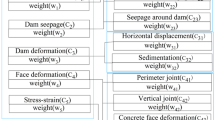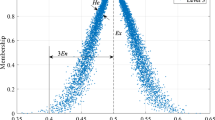Abstract
The assessment of flash flood risks is the basis on which flash flood prevention measures and early-warning systems can be proposed and reasonably implemented. However, inadequate monitoring of flash flood data which mainly occurs in remote areas restricts quantitative risk assessment. This study aimed to address the problems of limited data availability. A new model that integrating the Cloud-based Information Diffusion (CID) model and Analytic Hierarchy Process (AHP) approach is developed to assess flash flood risks. The proposed method improves the information diffusion function by introducing cloud model, while converting single-valued observations with incomplete information into fuzzy set-valued samples. The new approach can perform comprehensive risk assessment tasks with various indexes that are composed of incomplete information. Another advantage of this approach is that it can illustrate fuzzy uncertainty, fuzziness, and randomness of risk indexes by coupling with the cloud model, the risk magnitude is quantified with membership degree. A mountainous watershed in Southern China named Yangshan County was selected as the study area. Compared with information diffusion (ID) and entropy-based information diffusion (EID), the assessment results of the three models are, in general, consistent with one another, and agree with the reported values. According to the principle of maximum membership degree, Yangshan County is determined as a high-risk region when confronting with flash flood hazards. This model provides a feasible and effective method on fuzzy risk assessment of flash flooding, and is expected to be applied in other multi-criteria decision with limited available information or small sample problems.




Similar content being viewed by others
References
Abebe Y, Kabir G, Tesfamariam S (2018) Assessing urban areas vulnerability to pluvial flooding using GIS applications and Bayesian belief network model. J Clean Prod 174:1629–1641
Andrade MMN, Szlafsztein CF (2018) Vulnerability assessment including tangible and intangible components in the index composition: an Amazon case study of flooding and flash flooding. Sci Total Environ 630:903–912
Cheng K, Fu Q, Meng J, Li TX, Pei W (2018) Analysis of the spatial variation and identification of factors affecting the water resources carrying capacity based on the cloud model. Water Resour Manag 32(8):2267–2781
Chen LX, Westen CJV, Hussin H, Ciurean RL, Turkington T, Chavarro-Rincon D, Shrestha DP (2016) Integrating expert opinion with modelling for quantitative multi-hazard risk assessment in the eastern Italian Alps. Geomorphology 273:150–167
Deng Y, Liu SH, Zhang W, Wang L, Wang JH (2010) General multidimensional cloud model and its application on spatial clustering in Zhanjiang, Guangdong. J Geogr Sci 20(5):787–798
Elmoustafa AM, Mohamed MM (2013) Flash flood risk assessment using morphological parameters in Sinai peninsula. Open J Modern Hydrol 3(3):122–129
Fattahi R, Khalilzadeh M (2018) Risk evaluation using a novel hybrid method based on FMEA, extended MULTIMOORA, and AHP methods under fuzzy environment. Saf Sci 102:290–300
Fawcett T (2006) An introduction to ROC analysis. Pattern Recogn Lett 27(8):861–874
Feng LH, Hong WH (2009) On the principle of maximum entropy and the risk analysis of disaster loss. Appl Math Model 33(7):2934–2938
Feng LH, Huang CF (2007) A risk assessment model of water shortage based on information diffusion technology and its application in analyzing carrying cpacity of water resources. Water Resour Manag 22(5):621–633
Guangdong Academy of Sciences (1991) Guangdong mountainous landform. Guangdong Science and Technology Press, Guangdong (in Chinese)
Ghosh A, Kar SK (2018) Application of analytical hierarchy process (AHP) for flood risk assessment: a case study in Malda district of West Bengal, India. Nat Hazards 94(1):349–368
Gong L, Jin C (2009) Fuzzy comprehensive evaluation for carrying capacity of regional water resources. Water Resour Manag 23(12):2503–2513
Guangdong Hydropower Planning & Design Institute (2017) Evaluation report on the county-level zoning of flash flood disaster prevention in Guangdong Province (in Chinese)
Hydrological Bureau of Guangdong Province (2016) The report of flash floods risk analysis and evaluation in Yangshan County, Guangdong Province (in Chinese)
Huang CF (2001) Information matrix and application. Int J Gen Syst 30(6):603–622
Huang CF, Huang YD (2018) An information diffusion technique to assess integrated hazard risks. Environ Res 161:104–113
Jiang Z, Wu W, Qin H, Zhou J (2018) Credibility theory based panoramic fuzzy risk analysis of hydropower station operation near the boundary. J Hydrol 565:474–488
Kayastha P, Dhital MR, De Smedt F (2013) Application of the analytical hierarchy process (AHP) for landslide susceptibility mapping: a case study from the Tinau watershed, West Nepal. Comput Geosci 52:398–408
Konstantinos K, Thomas T, Micha H, Johannes H, Sven F (2016) Integrated flash flood vulnerability assessment: insights from East Attica, Greece. J Hydrol 541:553–562
Li Q, Zhou JZ, Liu DH, Jiang XW (2012) Research on flood risk analysis and evaluation method based on variable fuzzy sets and information diffusion. Saf Sci 50(5):1275–1283
Lu HW, Ren LX, Chen YZ, Tian PP, Liu J (2017) A cloud model based multi-attribute decision making approach for selection and evaluation of groundwater management schemes. J Hydrol 555:881–893
Mahmood MI, Elagib NA, Horn F, Saad SAG (2017) Lessons learned from Khartoum flash flood impacts: an integrated assessment. Sci Total Environ 601-602:1031–1045
Marchi L, Borga M, Preciso E, Gaume E (2010) Characterisation of selected extreme flash floods in Europe and implications for flood risk management. J Hydrol 394(1-2):118–133
Modrick TM, Georgakakos KP (2015) The character and causes of flash flood occurrence changes in mountainous small basins of Southern California under projected climatic change. J Hydrol Reg Stud 3:312–336
Murali RM, Ankita M, Amrita S, Vethamony P (2013) Coastal vulnerability assessment of Puducherry coast, India, using the analytical hierarchical process. Nat Hazards Earth Syst 13(12):3291–3311
Pirasteh S, Li J (2018) Developing an algorithm for automated geometric analysis and classification of landslides incorporating LiDAR-derived DEM. Environ Earth Sci 77(11):414
Radmehr A, Araghinejad S (2015) Flood vulnerability analysis by fuzzy spatial multi criteria decision making. Water Resour Manag 29(12):4427–4445
Saharia M, Kirstetter PE, Vergara H, Gourley JJ, Hong Y, Giroud M (2017) Mapping flash flood severity in the United States. J Hydrometeorol 18(2):397–411
Satty T (1980) The analytic hierarchy process. McGraw-Hill, New York
Schroeder AJ, Gourley JJ, Hardy J, Henderson JJ, Parhi P, Rahmani V, Reed KA, Schumacher RS, Smith BK, Taraldsen MJ (2016) The development of a flash flood severity index. J Hydrol 541:523–532
Sueyoshi T, Shang J, Chiang WC (2009) A decision support framework for internal audit prioritization in a rental car company: a combined use between DEA and AHP. Eur J Oper Res 199(1):219–231
Wu MH, Chen YN, Xu CC (2014) Assessment of meteorological disasters based on information diffusion theory in Xinjiang, Northwest China. J Geogr Sci 25(1):69–84
Xiao YF, Yi SZ, Tang ZQ (2018) A spatially explicit multi-criteria analysis method on solving spatial heterogeneity problems for flood Hazard assessment. Water Resour Manag 32(10):3317–3335
Xu LF, Xu XG, Meng XW (2012) Risk assessment of soil erosion in different rainfall scenarios by RUSLE model coupled with information diffusion model: a case study of Bohai rim, China. Catena 100(2):74–82
Yin J, Ye MW, Yin ZE, Xu SY (2015) A review of advances in urban flood risk analysis over China. Stoch Env Res Risk A 29(3):1063–1070
Zadeh LA (1965) Fuzzy sets. Inf Control 8(3):338–353
Zou Q, Zhou JZ, Zhou C, Guo J, Deng WP, Yang MQ, Liao L (2012) Fuzzy risk analysis of flood disasters based on diffused-interior-outer-set model. Expert Syst Appl 39(6):6213–6220
Acknowledgements
This work was supported by the outstanding Youth Science Foundation of NSFC (No. 51822908), the National Natural Science Foundation of China (No. 51709286 and No. 51779279), and the Guangdong Natural Science Foundation of China (No. 2017A030310065).
Author information
Authors and Affiliations
Corresponding author
Ethics declarations
Conflict of Interest
None.
Additional information
Publisher’s Note
Springer Nature remains neutral with regard to jurisdictional claims in published maps and institutional affiliations.
Rights and permissions
About this article
Cite this article
Zhong, M., Wang, J., Gao, L. et al. Fuzzy Risk Assessment of Flash Floods Using a Cloud-Based Information Diffusion Approach. Water Resour Manage 33, 2537–2553 (2019). https://doi.org/10.1007/s11269-019-02266-z
Received:
Accepted:
Published:
Issue Date:
DOI: https://doi.org/10.1007/s11269-019-02266-z




